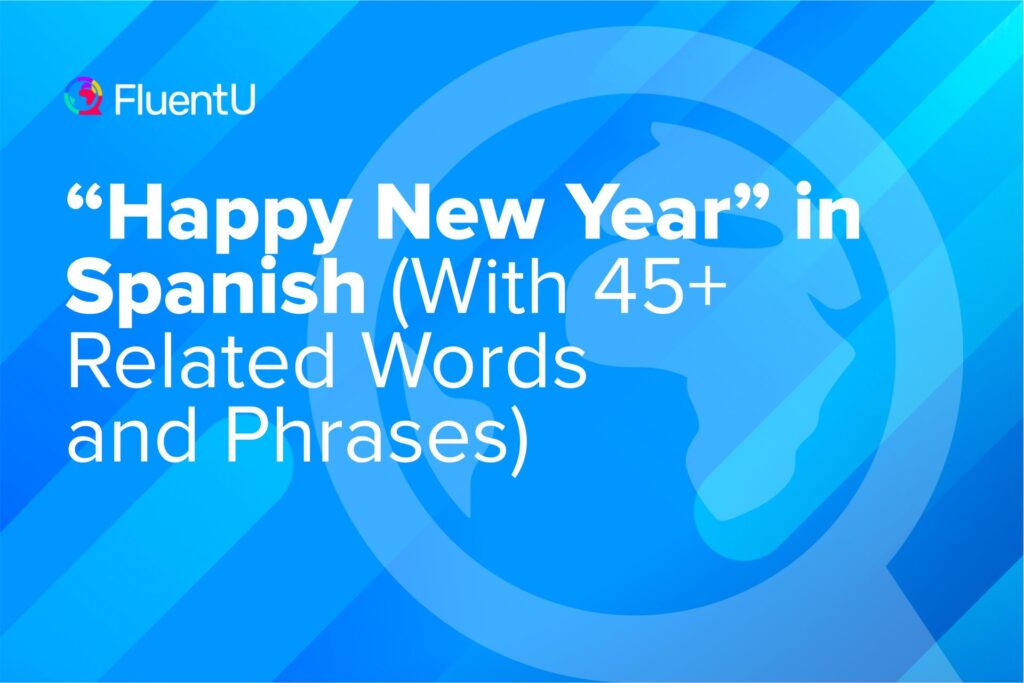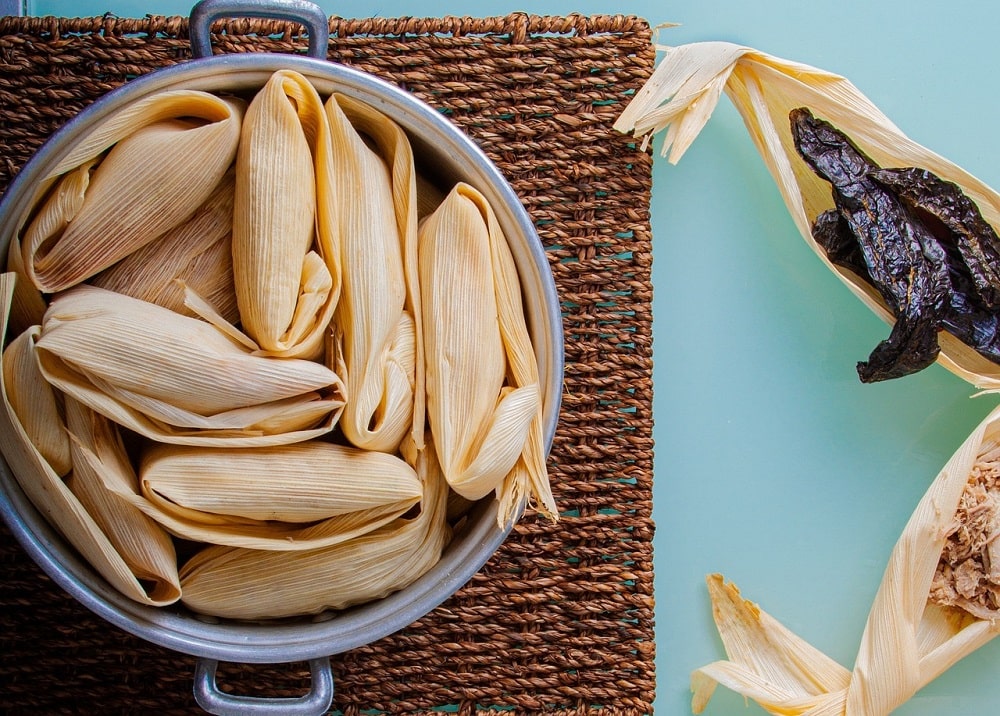“Happy New Year” in Spanish (With 45+ Related Words and Phrases)

New Year’s celebrations in Spanish-speaking countries are woven with a rich diversity of traditions and customs. From the exhilarating cheers of the clock striking midnight in Madrid’s Puerta del Sol to the enchanting burning of “Años Viejos” (Old Years) in Ecuador, each nation has its own unique way of welcoming the new year.
Discover how to say “Happy New Year” Feliz Año Nuevo in different ways and immerse yourself in the unique celebrations of the Spanish-speaking world.
Download: This blog post is available as a convenient and portable PDF that you can take anywhere. Click here to get a copy. (Download)
“Happy New Year” in Spanish: Feliz Año Nuevo
Here’s the most common, straightforward way to say happy New Year in Spanish:
- ¡Feliz Año Nuevo! — Happy New Year!
But it’s not the only way to say it! Read on to see even more New Year’s wishes.
Casual Greetings
- ¡Que tengas un excelente año! — May you have an excellent year!
- ¡Espero que el año nuevo te traiga muchas alegrías! — I hope the new year brings you lots of joy!
- ¡Que el próximo año te traiga sonrisas y aventuras emocionantes! — May the next year bring you smiles and exciting adventures!
- ¡Deseo que tu año nuevo esté lleno de risas y nuevos amigos! — I wish your New Year is filled with laughter and new friends!
Formal Greetings
- Les deseo un Año Nuevo lleno de logros y prosperidad. — I wish you a New Year filled with achievements and prosperity.
- Que en este nuevo año sus metas se cumplan y sus sueños se hagan realidad. — May your goals be achieved and your dreams come true in this new year.
- Espero que este próximo año esté colmado de éxitos y felicidad para usted y su familia. — I hope that this upcoming year is filled with success and happiness for you and your family.
Business and Professional Greetings
- En nombre de nuestra empresa, les deseamos un próspero Año Nuevo. — On behalf of our company, we wish you a prosperous New Year.
- Que este año sea lleno de logros y colaboración fructífera. — May this year be full of achievements and fruitful collaboration.
- Esperamos continuar nuestra exitosa asociación en el próximo año. — We look forward to continuing our successful partnership in the coming year.
All-purpose Greetings
- Le deseo un próspero Año Nuevo. — I wish you a prosperous New Year.
- Que este año esté lleno de bendiciones y éxitos. — May this year be filled with blessings and success.
- Deseándole un año lleno de salud, felicidad y amor. — Wishing you a year filled with health, happiness, and love.
Spanish New Year’s Vocabulary
Talk about the new year with these essential vocabulary words:
- Adiós al año viejo — Goodbye to the old year
- Año nuevo — New year
- Año venidero — Coming year
- Alegría y felicidad — Joy and happiness
- Brindar por… — To toast to…
- Brindis — Toast
- Buenos deseos — Good wishes
- Campanadas — Chimes (referring to the clock striking midnight)
- Celebración — Celebration
- Nuevo inicio — Fresh start
- Confeti — Confetti
- Cuenta regresiva — Countdown
- Desfile de año nuevo — New year’s parade
- Despedida del año — Farewell to the year
- Deseos de año nuevo — New year’s wishes
- Esperanza — Hope
- Esperanzas y sueños — Hopes and dreams
- Fiesta — Party
- Fuegos artificiales — Fireworks
- Medianoche — Midnight
- Nochevieja — New Year’s Eve
- Propósitos de año nuevo — New year’s resolutions
- Recuerdos del año — Year’s memories
- Reloj de la Puerta del Sol — Clock of the Puerta del Sol (in Madrid)
- Renovación — Renewal
- Propósitos — Resolutions
- Reunión familiar — Family gathering
- Tiempo para reflexionar — Time for reflection
- Uvas — Grapes (part of a new year’s tradition in Spain and Mexico)
- Víspera de año nuevo — New year’s eve
How to Write New Year’s Messages in Spanish
Writing New Year’s messages in Spanish allows you to convey warm wishes and good intentions to your Spanish-speaking friends and family. Here’s a brief guide on how to do so, along with important vocabulary:
- Start with a greeting: Begin your message with a friendly greeting such as Querido/Querida (Dear) or Hola (Hello).
- Express your wishes: Share your New Year’s wishes using phrases like ¡Feliz Año Nuevo! (Happy New Year!) or Que este nuevo año te traiga… (May this new year bring you…).
- Reflect on the past year: Acknowledge the past year and its experiences. For instance, you can write A pesar de los desafíos, espero que este nuevo año sea mejor (Despite the challenges, I hope this new year is better), or Mirando atrás, estoy agradecido por… (Looking back, I’m grateful for…).
- Mention resolutions or goals: If applicable, talk about resolutions or goals for the new year. For example, Espero que logres todos tus propósitos de año nuevo (I hope you achieve all your New Year’s resolutions).
- End with well wishes: Conclude your message with kind words, like Con cariño (With affection), Un fuerte abrazo (A big hug) and Te deseo lo mejor en el año que viene (I wish you the best in the coming year).
By using these phrases and vocabulary, you can craft heartfelt New Year’s messages in Spanish to make your loved ones feel special and cherished during this festive time!
New Year’s Resolutions in Spanish
When a new year comes around, you might set a resolution (or a few) that reflects your desire for self-improvement and personal growth in the coming year. The same is true for Spanish-speaking cultures, where making propósitos de año nuevo (New Year’s resolutions) is a common practice.
Just like in many other cultures, the start of a new year is seen as an opportunity for a fresh beginning and a chance to set goals that will lead to positive changes in various aspects of life:
- Family and Community: In many Spanish-speaking countries, there’s a strong sense of community and family. New Year’s resolutions often extend beyond personal goals to include intentions for improving relationships and contributing positively to the community.
- Symbolism: Some Spanish-speaking cultures have symbolic rituals related to resolutions. For instance, people might write their resolutions on a piece of paper, burn it and then scatter the ashes as a way to release the past and embrace the future.
- Health and prosperity: Health-related resolutions are common, reflecting the value placed on well-being. There’s also an emphasis on prosperity, both in terms of financial success and personal fulfillment.
I personally believe that resolutions (no matter when they’re made) should be specific and attainable. Here are a few examples of Spanish New Year’s resolution.
Why not write your own New Year’s resolutions in Spanish this year?
- Voy a hacer ejercicio regularmente para mantenerme en forma. — I’m going to exercise regularly to stay in shape.
- Mi propósito es pasar más tiempo de calidad con mi familia. — My resolution is to spend more quality time with my family.
- Voy a ahorrar dinero para viajar a un lugar que siempre he deseado visitar. — I’m going to save money to travel to a place I’ve always wanted to visit.
- Voy a dejar de fumar para mejorar mi salud. — I’m going to quit smoking to improve my health.
- Voy a dedicar tiempo cada día a leer para ampliar mis conocimientos. — I’m going to dedicate time every day to read and expand my knowledge.
- Quiero reducir mi consumo de azúcar y comer de manera más saludable. — I want to reduce my sugar intake and eat healthier.
- Mi propósito es practicar la gratitud diariamente para enfocarme en lo positivo. — My resolution is to practice gratitude daily to focus on the positive.
- Voy a unirme a un proyecto voluntario local para contribuir positivamente a mi comunidad. — I’m going to join a local volunteer project to positively contribute to my community.
- Quiero aprender un nuevo idioma este año. — I want to learn a new language this year.
If that last resolution resonates with you (and if you’re here on our blog, then it probably does), I have a tip for you: Don’t wait to start. It doesn’t have to be a new year for you to start learning Spanish, or any other language you’ve always wanted to learn.
Start by setting some specific goals, then dive right in. You don’t even have to start with a textbook—interactive programs like FluentU make learning Spanish as easy as watching videos.
FluentU takes authentic videos—like music videos, movie trailers, news and inspiring talks—and turns them into personalized language learning lessons.
You can try FluentU for free for 2 weeks. Check out the website or download the iOS app or Android app.
P.S. Click here to take advantage of our current sale! (Expires at the end of this month)

Spanish New Year’s Customs and Traditions
There are many New Year’s customs and traditions across various Spanish-speaking countries. Get into the festive spirit and cultural richness with these New Year’s celebrations:
- Las doce uvas de la suerte (The Twelve Lucky Grapes): In Spain and many Latin American countries, people eat 12 grapes as the clock strikes midnight on New Year’s Eve, making a wish with each grape for good luck and prosperity.
- Quema de Años Viejos (Burning of Old Years): In Ecuador and other Latin American countries, people create effigies representing the old year and burn them at midnight to symbolize letting go of the past and welcoming the new.
- Quema de Muñecos (Burning of Dolls): In Guatemala, people create and burn dolls representing disliked or negative things from the past year to start fresh.
- Velorio de Año Viejo (Wake of the Old Year): In parts of Colombia, people gather for a symbolic wake for the old year, sharing anecdotes and memories.
- Año Nuevo en la Playa (New Year’s on the Beach): It’s common to celebrate New Year’s on the beach, enjoying fireworks, music and a festive atmosphere.
- Baño de la Prosperidad (Bath of Prosperity): Some people take a symbolic bath on New Year’s Eve to wash away negativity and attract prosperity for the coming year.
- Ropa Interior de Colores (Colored Underwear): It’s traditional to wear colored underwear, each color symbolizing a different wish (e.g., red for love, yellow for wealth).
- Barrer la Mala Suerte (Sweeping Away Bad Luck): Some people sweep their homes before midnight to rid them of bad luck and negative energy from the previous year.
- Reyes Magos Procession (Three Wise Men Procession): In Spain and some Latin American countries, the arrival of the Three Wise Men on January 6th is celebrated with parades and gift-giving to mark the end of the holiday season.
- Desfile de Año Nuevo (New Year’s Parade): Cities like Mexico City hold colorful parades with floats, music, and dancing to celebrate the start of the new year.
- Fuegos Artificiales (Fireworks): Fireworks displays are common throughout Spanish-speaking countries to welcome the New Year with a bang and colorful lights.
- Campanadas (Chimes): Many towns and cities have the tradition of ringing church bells or other chimes at midnight on New Year’s Eve to mark the beginning of the new year.
Spanish New Year’s Food and Drinks
Do you have a traditional New Year’s meal? The following foods and drinks contribute to the festive atmosphere and culinary traditions of New Year’s celebrations across Spanish-speaking cultures.
Here are some traditional Spanish New Year’s food and treats:
- Lentejas (Lentils): In Spain and some Latin American countries, lentils are eaten as a symbol of prosperity and good luck for the coming year due to their coin-like appearance.
- Pavo Asado (Roast Turkey): Roast turkey is a popular dish for New Year’s celebrations, often enjoyed in family gatherings.
- Tamales (Tamales): These savory filled corn dough pockets wrapped in corn husks are a traditional New Year’s dish in many Latin American countries.
- Cordero Asado (Roast Lamb): Roast lamb is a festive dish enjoyed during New Year’s celebrations, especially in Spain.
- Cotechino con Lentejas (Sausage with Lentils): A dish from Spain and Italy, cotechino (a type of sausage) is often served with lentils for luck and prosperity.
- Bacalao (Salted Cod): Bacalao is a common dish in Spain for special occasions, including New Year’s, often served in various preparations.
- Roscón de Reyes (King’s Cake): In Spain, this ring-shaped cake is enjoyed on January 6th (Three Wise Men Day) and is often filled with cream or other sweet fillings.
And here are some traditional drinks to enjoy during the celebration:
- Cava (Cava): A sparkling wine similar to champagne, cava is a popular choice for New Year’s toasting in Spain.
- Sidra (Cider): In regions like Asturias, Spain, and some parts of Latin America, cider is enjoyed during New Year’s celebrations.
- Ponche Crema (Eggnog-like Beverage): A creamy, rum-based drink often enjoyed in Venezuela during the holiday season.
- Cola de Mono (Monkey’s Tail): A traditional Chilean drink made with coffee, milk, spices, and aguardiente (a type of alcohol).
- Coquito (Coquito): A Puerto Rican coconut-based drink often enjoyed during Christmas and New Year’s celebrations.
- Anís (Anise Liqueur): Anise-flavored liqueurs, such as Anís del Mono, are popular for toasting in Spain and other Spanish-speaking countries.
Test Yourself: Spanish New Years Quiz!
Prepare to greet the new year… in Spanish! Eat, drink and use the phrases in this post to celebrate the arrival of a new year, the way Spanish speakers do.
And One More Thing…
If you've made it this far that means you probably enjoy learning Spanish with engaging material and will then love FluentU.
Other sites use scripted content. FluentU uses a natural approach that helps you ease into the Spanish language and culture over time. You’ll learn Spanish as it’s actually spoken by real people.
FluentU has a wide variety of videos, as you can see here:

FluentU brings native videos within reach with interactive transcripts. You can tap on any word to look it up instantly. Every definition has examples that have been written to help you understand how the word is used. If you see an interesting word you don’t know, you can add it to a vocab list.

Review a complete interactive transcript under the Dialogue tab, and find words and phrases listed under Vocab.

Learn all the vocabulary in any video with FluentU’s robust learning engine. Swipe left or right to see more examples of the word you’re on.

The best part is that FluentU keeps track of the vocabulary that you’re learning, and gives you extra practice with difficult words. It'll even remind you when it’s time to review what you’ve learned. Every learner has a truly personalized experience, even if they’re learning with the same video.
Start using the FluentU website on your computer or tablet or, better yet, download the FluentU app from the iTunes or Google Play store. Click here to take advantage of our current sale! (Expires at the end of this month.)










